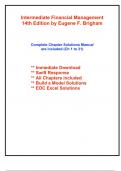Intermediate Financial Management
14th Edition by Eugene F. Brigham
Complete Chapter Solutions Manual
are included (Ch 1 to 31)
** Immediate Download
** Swift Response
** All Chapters included
** Build a Model Solutions
** EOC Excel Solutions
, Chapter 1
An Overview of Financial Management and
The Financial Environment
ANSWERS TO BEGINNING-OF-CHAPTER QUESTIONS
1-1 The primary goal is assumed to be shareholder wealth maximization, which translates to
stock price maximization. That, in turn, means maximizing the PV of future free cash
flows.
Maximizing shareholder wealth requires that the firm produce things that customers
want, and at the lowest cost consistent with high quality. It also means holding risk
down, which will result in a relatively low cost of capital, which is necessary to
maximize the PV of a given cash flow stream.
This also gets into the issue of capital structure—how much debt should we use? The
more debt the firm uses, the lower its taxes, and the fewer shares outstanding, hence less
dilution of earnings. However, more debt means more risk. So, it’s necessary to
consider capital structure when attempting to maximize share prices.
Dividend policy is also an issue—how much of its earnings should the firm pay out as
dividends? The answer to that question depends on a number of factors, including the
firm’s investment opportunities, its access to capital markets, its stockholders’ desires
(and their tax rates), and the kind of signals stockholders get from dividend actions.
Shareholder wealth maximization is partially consistent and partially inconsistent
with generally accepted societal goals. It is consistent because well-run firms produce
good products at low costs, sell them at competitive prices, employ people, pay taxes, and
generally improve society. However, without constraints, firms would tend to form
monopolies and end up charging prices that are too high and not producing enough
output. They might also pollute the air and water, engage in unfair labor practices, and so
on. So, constraints (antitrust, labor, environmental, etc. laws) should be and are imposed
on businesses. That said, stock price maximization is consistent with a strong
economy, economic progress, and “the good life” for most citizens.
In standard introductory microeconomics courses, we assume that firms attempt to
maximize profits. In more advanced econ courses, the goal is broadened to value
maximizing, so finance and economics are indeed consistent.
As WorldCom, Enron, and other corporate scandals demonstrated very clearly,
managers do not always have stockholders’ interests as a primary goal—some managers
have their own interests. This point is discussed further below.
, 1-2 See the model for quantitative answers to this question. All of these valuations involve
applications of the basic valuation model:
N
CFt
Value = ∑ .
t =0 (1 + r) t
Values for CFt , r, and N are specified. For bonds, the CFs are interest payments and the
maturity value, and N is the bond’s life. Other things held constant, the higher the going
interest rate, r, the lower the value of the bond. Also, if the coupon rate is high, then CFs
are also high, and that increases the value of the bond. For a stock, the CFs are
dividends, and for a capital budgeting project, they are operating cash flows.
The main point to get across with this question is that all assets are valued in
essentially the same way. The Excel model goes into a little more detail on sensitivity
analysis. Much more comes later in the book.
1-3 The advantages of a corporate form of ownership are that investor liability is limited to
the amount invested, corporations can raise capital through public offerings of stock, and
ownership can be easily transferred from person to person by simply selling shares of
stock. In a sole proprietorship or partnership, on the other hand, the owner or owners are
exposed to potentially unlimited liability, it is difficult to raise equity capital since either
new partners must be found or the existing partners must put up additional capital, and it
is difficult to transfer ownership between partners or from a sole proprietor to someone
else.
The disadvantages of the corporate form are that there are numerous forms that must
be filled out and regulations that must be followed that are not required of a sole
proprietorship or a partnership, corporations are subject to double taxation of distributed
earnings in that the corporation first pays taxes on the pre-tax income, and then the
owners must pay tax on the dividend or capital gains income, and the separation of
ownership (by the shareholders) and control (by management) can result in management
taking actions that are not in the owners’ best interests.
1-4 The cost of money is affected by (1) production opportunities, (2) the time preference for
consumption, (3) risk, and (4) inflation. When production opportunities are good, and
assets are earning high rates of return, then interest rates tend to be higher because there
is a larger demand for borrowing to finance these projects. Also, investors who are
considering lending money recognize that their alternative investments have a high
return, and so demand a high return on their investments. When investors have a strong
preference for current consumption, then they demand a higher return on their
investments to compensate them for having to defer current purchases, and so the cost of
money is higher. Investors demand a higher rate of return on riskier investments in order
to compensate them for the having to be exposed to more risk, and when investors expect
future inflation, then the cost of money increases so that investment returns better cover
this future price increase.





